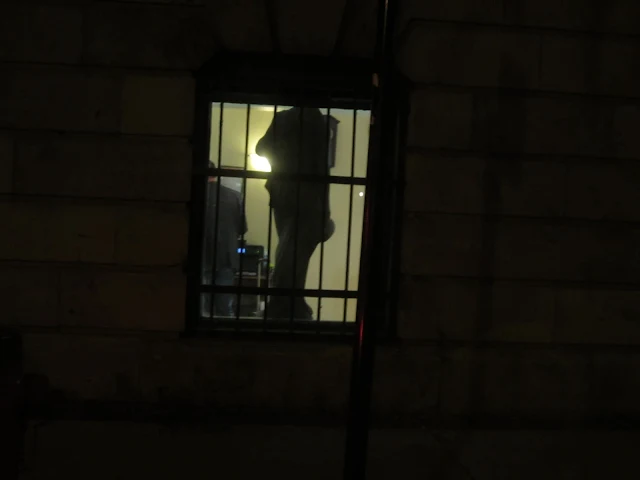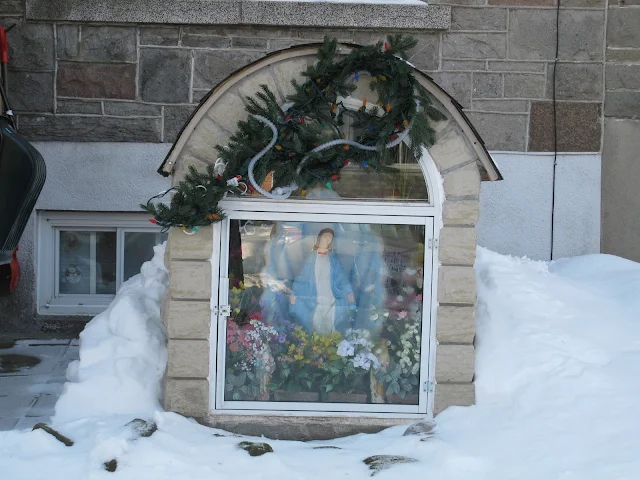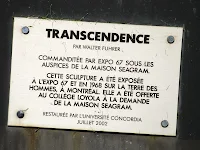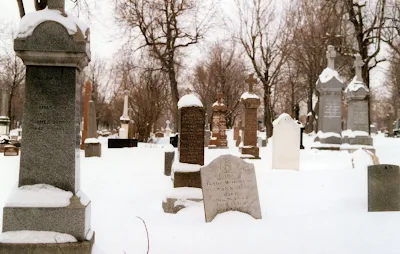And it was at that age... Poetry arrived
in search of me. I don't know, I don't know where
it came from, from winter or a river.
"Poetry" by Pablo Neruda
(trans. Alastair Reid)
Pablo Neruda, Selected Poems
(Penguin Books, 1975, page 218-219)
Tuesday, March 1, 2011
Sunday, February 27, 2011
Holy Wells, Montreal (continuation)
Continuing my search for "holy wells," here is a view of water appearing through the earth and snow in Loyola Park in western NDG. See previous entries for more information on this site and the topic of "holy wells." The City of Montreal's error was locating their experimental ecological site in the wrong place, it should have been where the water appears on the surface of the earth.
Saturday, February 26, 2011
Beyond Truth Is Compassion
Truth is not happy, cannot
make us happy or feel joy;
if truth were happy,
none of us would lie,
none of us would dispute
the others truth.
What brings people together?
Not truth but compassion,
make us happy or feel joy;
if truth were happy,
none of us would lie,
none of us would dispute
the others truth.
What brings people together?
Not truth but compassion,
Monday, February 21, 2011
C.G. Jung and the importance of family history
This quotation, from C.G. Jung’s Memories, Dreams, Reflections, was published in Harvey Shepherd’s “A Note From the Co-President” column in the March 2011 issue of The Newsletters of the C.G. Jung Society of Montreal. I feel it expresses something of what I have been trying to do in my own work on my family’s history (which can be found at http://www.morrisseyfamilyhistory.com/); in much of my published poetry, for instance in Girouard Avenue (2009); in my essay, A Poet’s Journey: Notes on poetry and what it means to be a poet, published by Poetry Quebec (at http://www.poetry-quebec.com/pq/essay/article_80.shtml); and in this space.
Jung writes,
When I was working on the stone tablets, I became aware of the fateful links between me and my ancestors. I feel very strongly that I am under the influence of things or questions which were left incomplete and unanswered by my parents and grandparents and more distant ancestors. It often seems as if there were an impersonal karma within a family, which is passed on from parent to children. It has always seemed to me that I had to answer questions which fate had posed to my forefathers, and which had not yet been answered, or as if I had to complete, or perhaps continue, things which previous ages had left unfinished. It is difficult to determine whether these questions are more of a personal or more of a general (collective) nature. It seems to me that the latter is the case. (p. 233)
This is continued on page 236:
… it is precisely the loss of connection with the past, our uprootedness, which has given rise to the “discontents” of civilization and to such a flurry and haste that we live more in the future and its chimerical promises of a golden age than in the present, with which our whole evolutionary background has not yet caught up. We rush impetuously into novelty, driven by a mourning sense of insufficiency, dissatisfaction and restlessness. We no longer live on what we have, but on promises, no longer in the light of the present day, but in the darkness of the future, which, we expect, will at last bring the proper sunrise … The less we understand of what out fathers and forefathers sought, the less we understand ourselves, and thus we help with all our might to rob the individual of his roots and his guiding instincts, so that he becomes a particle in the mass, ruled only by what Nietzsche called the spirit of gravity.
Jung writes,
When I was working on the stone tablets, I became aware of the fateful links between me and my ancestors. I feel very strongly that I am under the influence of things or questions which were left incomplete and unanswered by my parents and grandparents and more distant ancestors. It often seems as if there were an impersonal karma within a family, which is passed on from parent to children. It has always seemed to me that I had to answer questions which fate had posed to my forefathers, and which had not yet been answered, or as if I had to complete, or perhaps continue, things which previous ages had left unfinished. It is difficult to determine whether these questions are more of a personal or more of a general (collective) nature. It seems to me that the latter is the case. (p. 233)
This is continued on page 236:
… it is precisely the loss of connection with the past, our uprootedness, which has given rise to the “discontents” of civilization and to such a flurry and haste that we live more in the future and its chimerical promises of a golden age than in the present, with which our whole evolutionary background has not yet caught up. We rush impetuously into novelty, driven by a mourning sense of insufficiency, dissatisfaction and restlessness. We no longer live on what we have, but on promises, no longer in the light of the present day, but in the darkness of the future, which, we expect, will at last bring the proper sunrise … The less we understand of what out fathers and forefathers sought, the less we understand ourselves, and thus we help with all our might to rob the individual of his roots and his guiding instincts, so that he becomes a particle in the mass, ruled only by what Nietzsche called the spirit of gravity.
Sunday, February 20, 2011
A walk in NDG (one)
Here we are, walking on a winter day in Notre Dame de Grace. Quebec may be the most secular place in North America, but there are still many examples of religious symbolism. The presence of the numinous in everyday life helps us connect with the divine. I have tried to show evidence of this, of manifestations of spirit in everyday life, among everyday people, in these "walks in NDG." Society can try to repress spirit, make those who adhere in spirit look ignorant and old-fashioned, but spirit surfaces in its important psychic role in our lives, spirit has an archetypal role in life that cannot be repressed for long before it emerges in some new and relevant form. This street is a few blocks from where I live. It is January 2011.
Sunday, February 13, 2011
The Motel Raphael today...
Someone had big plans to build on the site of the old Motel Raphael, just off Highway 2 & 20, the St. Jacques exit. Anywhere else this may have been a good plan, location, traffic, proximity to other buisnesses, it all seemed idea, but it seems to have fizzled out here in Montreal. The Motel Raphael was a fixture in this area of the city, a low cost motel... Photo taken in January 2011.
Tuesday, February 8, 2011
Decarie Square (two)
Decarie Square is home to various stores, a Winners, Sear's Warehouse, a motor vehicle bureau, a big Corrections Canada parole office, a two dollar cinema, various rug and carpet stores, and so on, assuming these stores haven't closed by now. It is just off the Decarie Expressway, and is worth a visit. Most people think of this as a failed shopping mall, failed probably because of its location and the changing demographics of the area.
Thursday, February 3, 2011
Thursday, January 27, 2011
Transcendence (2)
This scultpure, "Transcendence," by Jack Harman is located on the campus of
the University of British Columbia, outside of what used to be the faculty club.
Saturday, January 22, 2011
Transcendence (1)
Located on the Loyola campus of Concordia University, outside of the Hingston Hall residence, is Walter Fuhrer's sculpture, "Transcendence."
Thursday, January 20, 2011
Saturday, January 15, 2011
All's Good
Painted on the side of a former IGA grocery store next to the Montreal West train station and just a block from where Artie Gold used to live; this building was demolished last summer and condos are being built at this location.
January 15th, 2011: This is the birthday of two dear old friends: Veeto, my friend from Oxford Avenue days and Hoolahan's flats, from the early 1950s, who lives in Australia, and my old friend Artie Gold who I met in the early 1970s. God bless both of them. How dull and boring life would be without people like Veeto and Artie, they bring life and enthusiasm and spirit to everyone they meet. It was Veeto who told me that "LG" means "Life is good," so when I saw this painted sign I thought of her. Artie would have been 64 years old today; he is still missed by all of us who knew him. Coincidentally, Veeto (who never met Artie) knew Mary Brown, Artie's companion on Lorne Crescent, when Mary worked at a summer camp years before Mary and Artie met. Veeto and Artie are the kind of people I love, people who embrace life and who are bigger than life, people who take chances and sing, loudly, as they walk along the street, or who just have to stop at every second store to buy something to eat. These are people who remind us that life is meant for living, for creating, for loving, that life is not to be lived in fear, or for money, or for what we can get. These are people who changed my life for the better!
Sunday, January 9, 2011
Archetypal Patterns in Poetry
.JPG) |
| October 2012 |
In an article, “On the relation of analytical psychology to poetic art,” Dr. C.G. Jung has set forth an hypothesis in regard to the psychological significance of poetry. The special emotional significance possessed by certain poems—a significance going beyond any definite meaning conveyed—he attributes to the stirring in the reader’s mind, within or beneath his conscious response, of unconscious forces which he terms “primordial images,” or archetypes. These archetypes he describes as “psychic residua of numberless experiences of the same type,” experiences which have happened not to the individual but to his ancestors, and of which the results are inherited in the structure of the brain, a priori determinants of individual experience.
From Archetypal Patterns in Poetry: Psychological studies in imagination, by Maud Bodkin, Vintage Books, New York, 1958; first published in 1934
Thursday, January 6, 2011
Saturday, January 1, 2011
Holy Wells, Montreal (late August, 2010)
Last summer, I wrote here about holy wells in Ireland and in Montreal. Here is the effort of the City of Montreal to deal with a natural occurring well in Loyola Park, in western N.D.G. The bottom photograph shows the site of the well, it's on the far left towards the top. Yearly run-off from the well, or underground stream, has caused the asphalt to lift on the footpath to Fielding Avenue (not shown, but visible in a Google street view of "Fielding and Doherty, Montreal"). This neighbourhood, Notre Dame de Grace, has many underground streams, as do other areas of Montreal. It's not so long ago that this was country...
Update on 10 September 2018: The St-Pierre River, which has been covered with asphalt and buildings, runs under different parts of NDG; it originates in Old Montreal and ends at the Meadowbrook Golf Course in Cote St-Luc. Wouldn't it be great if we could see parts of this river restored aboveground? Re. this experiment in Loyola Park, it failed because some people were afraid it would cause disease as they believed mosquitoes would breed in the water; however, it also dried up and I suspect the amount of water in this experimental area was a lot less than originally estimated... SM
Tuesday, December 28, 2010
Vision in Poetry
It is a constant struggle to write from one’s vision
when there are so many people who oppose what one has to say.
It is a constant struggle to be true to one’s vision,
to be true to one’s self over a lifetime of writing.
It is a constant struggle
to be strong, strong in one’s vision,
not give up, not surrender, not lose one’s vision.
_________________________
I wrote the above on staying strong, not being deterred from one's poetic vision, after experiencing how pernicious this can be, when even people you thought were your friends end up not being friends at all...
when there are so many people who oppose what one has to say.
It is a constant struggle to be true to one’s vision,
to be true to one’s self over a lifetime of writing.
It is a constant struggle
to be strong, strong in one’s vision,
not give up, not surrender, not lose one’s vision.
_________________________
I wrote the above on staying strong, not being deterred from one's poetic vision, after experiencing how pernicious this can be, when even people you thought were your friends end up not being friends at all...
Wednesday, December 22, 2010
At Cote des Neiges Cemetery, Montreal
I've walked in Cote des Neiges Cemetery many times, including winter when some roads were closed due to the snow. I know it seems "morbid" to some people--hanging out in cemeteries--but walking in cemeteries has always been very pleasant for me. Like many people, when in foreign cities, I visit museums and historical sites, but also cemeteries. It has to do with an interest in family history, but in Montreal cemeteries are also places with green spaces and the quiet of the country in the city. Increasingly, cemeteries are nature preserves. There is bird watching, walking, and even some biking through the cemetery. Most of all, there is a sense of history and a place of quiet that you rarely find elsewhere in the city.
Cote des Neiges is the traditionally Catholic cemetery in Montreal, owned by the Sulpician Order that once owned the Island of Montreal, and still owns Notre Dame Basilica in Old Montreal, the College de Montreal, and Le Grand Seminaire de Montreal just east of the corner of Sherbrooke Street West and Atwater. This is the cemetery for Montreal's French and Irish and now many others, new people who live here, who are a part of the multi-cultural aspect of the city that helps make it the interesting place that it is.
Cote des Neiges is the traditionally Catholic cemetery in Montreal, owned by the Sulpician Order that once owned the Island of Montreal, and still owns Notre Dame Basilica in Old Montreal, the College de Montreal, and Le Grand Seminaire de Montreal just east of the corner of Sherbrooke Street West and Atwater. This is the cemetery for Montreal's French and Irish and now many others, new people who live here, who are a part of the multi-cultural aspect of the city that helps make it the interesting place that it is.
Monday, December 20, 2010
Subscribe to:
Posts (Atom)

















































